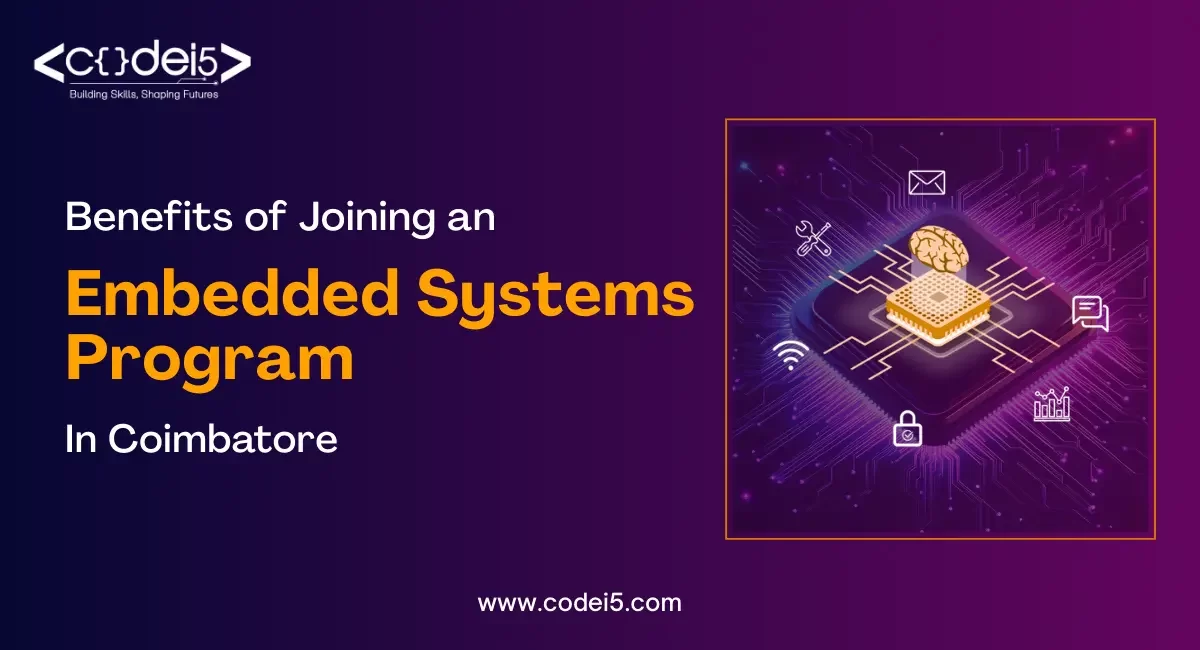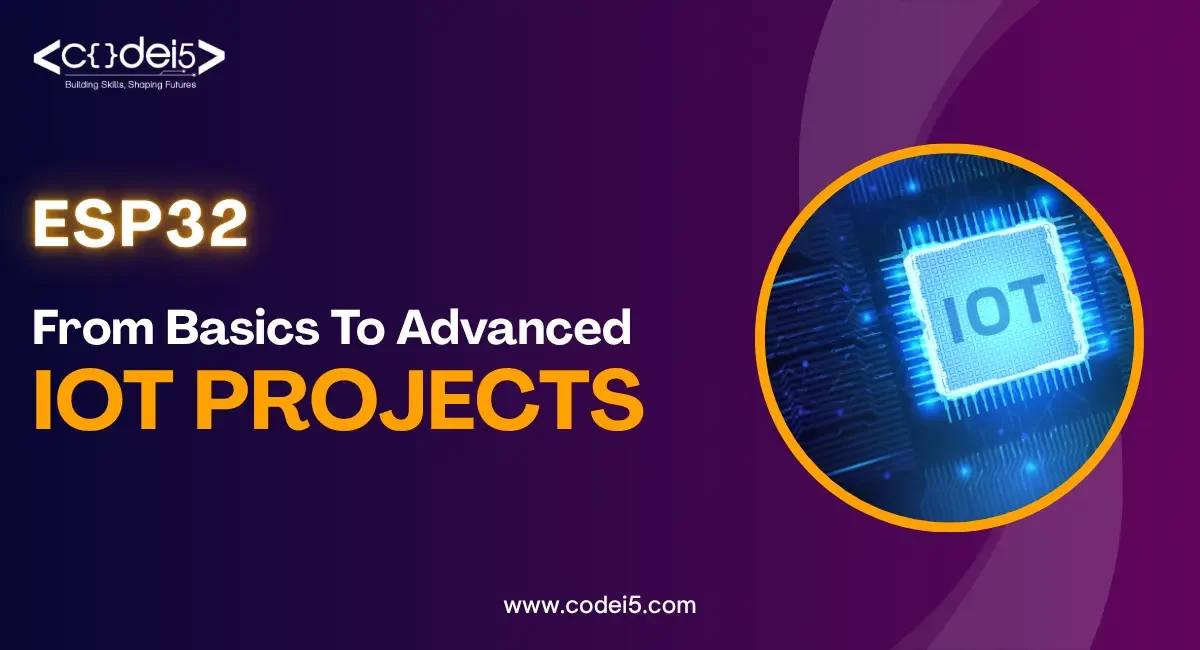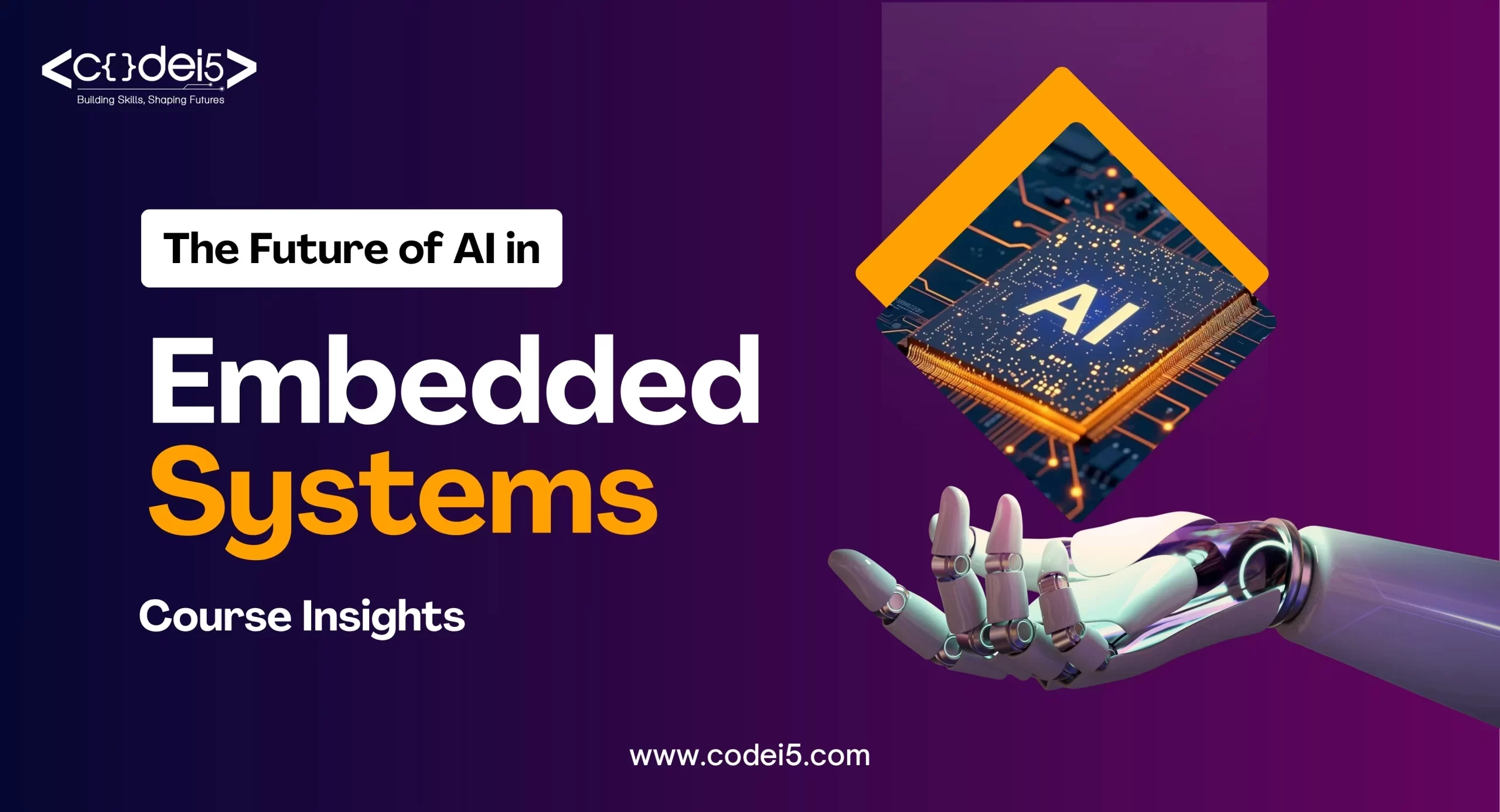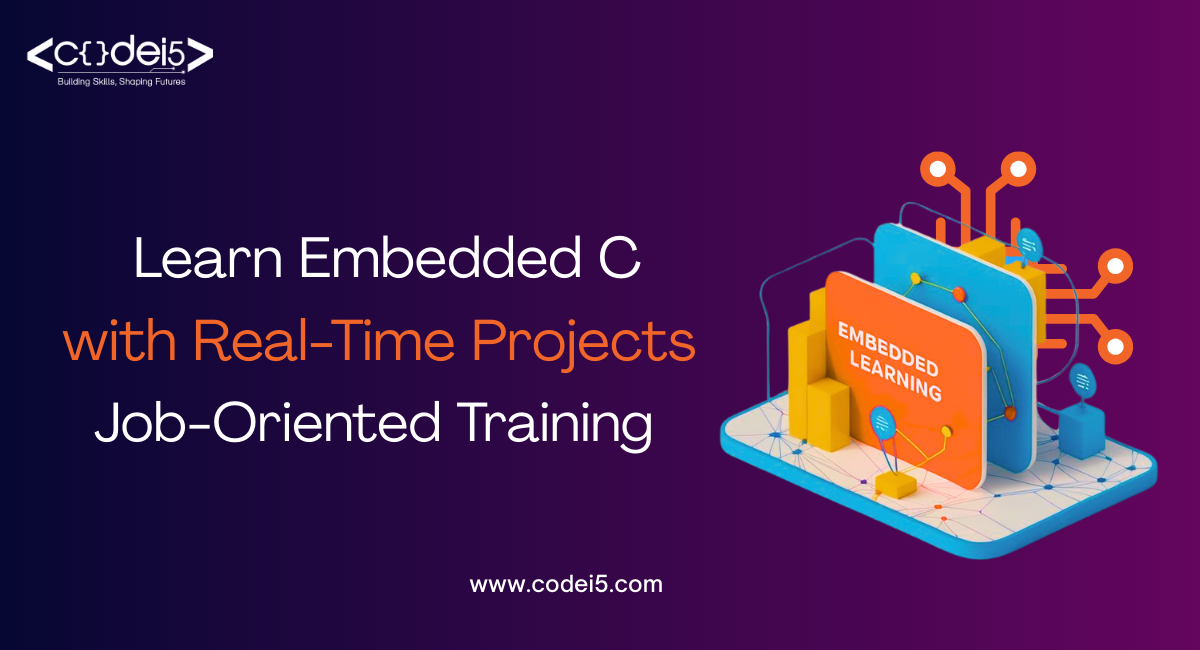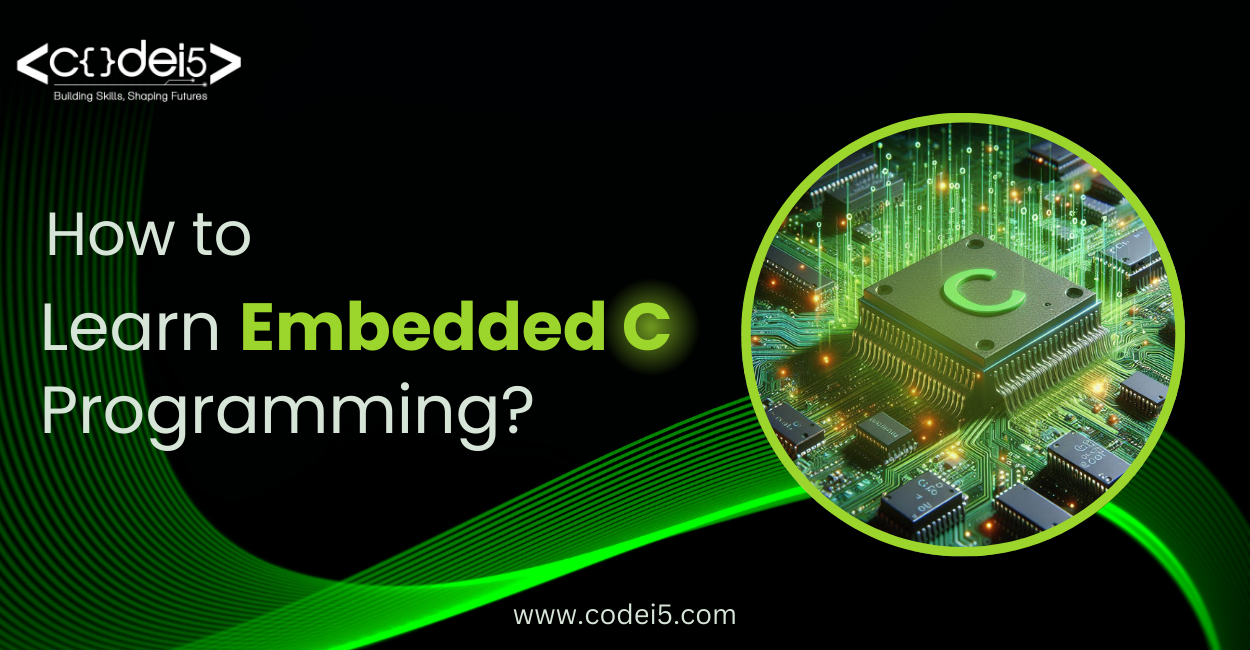
Embedded C programming is a specialized form of the C programming language designed for creating software for embedded systems. Embedded systems are electronic devices with specific functions, often controlled by a computer program. You interact with them daily through smartphones, appliances, cars, and various industrial machines.
This blog aims to offer a clear and structured way to learn Embedded C programming. By following the steps and using the suggested resources, you’ll build the skills needed to create software for embedded systems effectively. By the end, you’ll have a strong foundation in Embedded C programming and be ready to start your journey as an embedded systems developer.
Understanding the Basics
Introduction to C Programming
Variables and Data Types
- Variables: Containers used to store data.
- Data Types: Different kinds of data you can work with, such as integers, floating-point numbers, and characters.
- Declaration and Initialization: How to create variables and assign them initial values.
Operators
- Arithmetic Operators: Perform mathematical operations, like +, -, *, /, and %.
- Relational Operators: Compare values, including ==, !=, <, >, <=, and >=.
- Logical Operators: Used for logical operations, such as &&, ||, and !.
- Bitwise Operators: Operate on the binary representations of numbers, like &, |, ^, ~, <<, and >>.
Control Flow Statements
- Conditional Statements: Direct the flow of execution based on conditions, using if, else, and else if.
- Loops: Repeat code blocks using for, while, and do-while.
- Switch Statements: Select and execute code blocks based on specific values.
Pointers and Memory Management
- Pointers: Variables that store memory addresses.
- Dereferencing: Accessing the value at a particular memory address.
- Dynamic Memory Allocation: Using functions like malloc and free to manage memory during runtime.
- Memory Management Techniques: Avoiding common issues such as memory leaks and buffer overflows.
Functions and Modular Programming
- Functions: Blocks of code designed to perform specific tasks and can be reused.
- Function Declaration and Definition: How to declare a function’s name, return type, and parameters, and then define what the function does.
- Function Calls: Invoking functions and passing arguments to them.
- Function Prototypes: Declaring functions before their actual definitions in the code.
Modular Programming
Dividing code into smaller, manageable units to enhance readability and maintainability.
Understanding Embedded C Programming
What is Embedded C?
- Definition: A subset of the C language specifically designed for programming embedded systems.
- Explanation: Includes features and libraries for interacting with hardware, managing real-time operations, and handling resource constraints.
Difference Between C and Embedded C
- Hardware Interaction: Embedded C often involves direct communication with hardware components like microcontrollers and peripherals.
- Resource Constraints: Embedded systems typically have limited memory and processing power, requiring optimized code.
- Real-Time Requirements: Many embedded systems must meet strict timing constraints, necessitating real-time programming techniques.
Applications of Embedded C
- Automotive: Engine control units, infotainment systems, and driver assistance technologies.
- Consumer Electronics: Smartphones, smart appliances, and gaming consoles.
- Industrial Automation: Robotics, factory automation, and process control.
- Medical Devices: Diagnostic equipment and patient monitoring systems.
- IoT Devices: Smart home technologies, wearables, and industrial IoT solutions.
Examples of Embedded Systems Using Embedded C:
- Arduino Boards
- Raspberry Pi
- Automotive ECUsIndustrial Controllers
- Medical Diagnostic Equipment
By mastering these fundamental concepts, you’ll be well-prepared to explore the world of Embedded C programming and its diverse applications.
Getting Started with Embedded C
Prerequisites:
Basic Knowledge of C Programming:
You need to understand the basics of C, such as its syntax, data types, control structures (like loops and conditionals), and functions.
Understanding Hardware Concepts:
Get familiar with microcontrollers, microprocessors, I/O ports, memory, and basic digital logic. This helps you understand how embedded systems work.
Setting Up Your Development Environment
Choosing a Compiler and IDE:
- Arm GCC: A free compiler for Arm-based microcontrollers.
- IAR Embedded Workbench: A commercial tool with many features for different microcontrollers.
- Keil uVision: A user-friendly IDE for Arm microcontrollers with a lot of tools.
- MPLAB X: IDE for Microchip’s PIC microcontrollers.
Installing Necessary Tools:
Download and install your chosen compiler and IDE. Also, get any extra libraries or development boards you might need. Follow the installation instructions provided by the tool makers.
Core Concepts of Embedded C Programming
Basics of Embedded Systems
Microcontrollers and Microprocessors
- Microcontrollers: Single-chip systems with built-in features like memory and I/O ports, used in small, dedicated devices.
- Microprocessors: More powerful processors used in larger systems, often needing extra memory and components.
- I/O Ports and Interfacing: Learn how to connect and communicate with external devices. This includes digital inputs/outputs, analog-to-digital converters (ADCs), and digital-to-analog converters (DACs). You’ll use methods like GPIO (General Purpose Input/Output), UART, I2C, SPI, and USB.
Essential Embedded C Programming Skills
Writing Simple C Programs:
Practice writing basic C programs to control hardware, perform calculations, and manage data. Focus on making your code efficient and timely.
Handling I/O Operations:
Learn how to read from and write to devices. Use interrupts to handle events that happen suddenly or outside of regular program flow.
Memory Management:
Manage memory effectively, keeping in mind the limited resources in embedded systems. Learn about memory allocation, deallocation, and avoiding issues like memory leaks.
Additional Tips:
- Choose a small project to practice and build your confidence.
- Learn how to use the debugger in your IDE to find and fix errors.
- Don’t be afraid to try new things and test different hardware and software setups.
- Connect with other developers online to share knowledge, ask questions, and get support.
By following these steps and practicing regularly, you’ll be ready to dive into the world of embedded systems development with Embedded C.
Practical Tips for Learning Embedded C
Hands-On Practice
Importance of Practical Experience:
Gaining hands-on experience is crucial for mastering Embedded C. Working on real projects helps you understand concepts better and develop problem-solving skills.
Suggested Projects for Beginners:
- Blinking an LED: A basic project that introduces you to controlling hardware and using delays.
- Simple Sensor Interfacing: Connect and read data from sensors like temperature sensors or light sensors to learn abouft I/O operations and data handling.
Recommended Books and Online Courses
Books:
- “Embedded C Programming and the Microchip PIC” by Richard H. Barnett
- “Programming Embedded Systems in C and C++” by Michael Barr and Anthony Massa
Courses
Codei5 Academy: Known for its comprehensive Embedded Systems training, including top-notch Embedded C programming courses.
Useful Websites and Forums for Embedded C Programming
Websites:
Embedded.com: Offers articles, tutorials, and insights on embedded systems.
Forums:
- Stack Overflow: A valuable resource for troubleshooting and asking questions related to Embedded C.
- EEVblog Forum: Focuses on electronics and embedded systems, where you can find discussions and advice from experienced developers.
Additional Learning Resources
Recommended Books and Courses:
- For beginners, “Embedded C Programming and the Microchip PIC” is highly recommended for understanding basic concepts and practical applications.
- For advanced learners, “Programming Embedded Systems in C and C++” provides deeper insights into complex topics.
Online Communities and Forums:
- Reddit: Subreddits like r/embedded and r/embeddedlinux offer a space for discussion and support.
- Microchip Forum: A dedicated forum for Microchip product users, offering support and advice.
Practical Projects to Apply Your Knowledge:
- Home Automation Projects: Use Embedded C to create systems that control lights, appliances, or other devices from a smartphone.
- Robotics Projects: Build simple robots and program them to perform tasks, helping you understand real-time processing and control.
By incorporating hands-on practice with these resources, including the renowned training offered by Codei5 Academy, you’ll enhance your skills and knowledge in Embedded C programming effectively.
Troubleshooting and Debugging
Learning to code in Embedded C comes with its challenges. Here’s how to tackle common issues and debug your code effectively.
Common Issues and How to Solve Them?
- Syntax Errors: Mistakes like missing semicolons or mismatched parentheses. Use your IDE’s error checking to spot these issues and review your code carefully.
- Logic Errors: The code runs but doesn’t work as expected. Check your code step by step, verify calculations, and test smaller functions individually.
- Hardware Issues: Problems might stem from faulty hardware or poor connections. Double-check your wiring and component setup.
Using Debugging Tools
- Print Statements: Use printf to display variable values and track code execution.
- Debuggers: Use your IDE’s debugger to set breakpoints, pause execution, and inspect variables at specific points.
- Logic Analyzers: These tools help you see detailed signal activity on the hardware, useful for diagnosing timing issues.
Tips for Effective Learning
- Start Small: Begin with simple projects to build confidence and understand basic concepts.
- Practice Regularly: Dedicate time to work on projects and strengthen your skills consistently.
- Seek Help: Use online forums and communities for advice. Connect with mentors for additional guidance.
- Stay Updated: Keep up with new technologies and trends in embedded systems to remain competitive.
Conclusion
This blog has outlined a clear path to learning Embedded C programming. Start with small projects, practice often, and use the available resources to improve. Dive in and start your journey into the world of Embedded C!
Ready to get started? Explore resources, practice regularly, and embrace the learning process!



